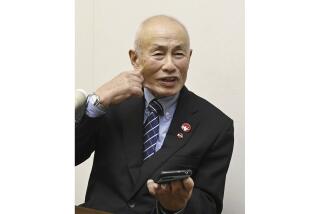World War II Ended, Cold War Started With A-Bomb
- Share via
“The hour was early, the morning still, warm and beautiful,” Hiroshima physician Michihiko Hachiya would remember later.
Suddenly, there was “a sharp, blinding flash of light. . . . Outside the city, the sky was a beautiful golden yellow, and there had been a deafening roar of sound.”
Hachiya and his wife fled through a courtyard. “We tripped over something and fell sprawling into the street. Getting to my feet, I discovered that I had tripped over a man’s head. ‘Excuse me! Excuse me, please!’ I cried.”
At 8:16 on the morning of Aug. 6, 1945, the B-29 Enola Gay dropped the world’s first atomic weapon, a bomb called “Little Boy,” on the Japanese industrial city of Hiroshima. Within a second of the midair detonation, the temperature at ground zero reached 5,400 degrees. Anyone outdoors within half a mile was incinerated; anyone within three miles was badly burned. The flash of heat was followed by a shock wave that sent glass and timbers flying, then a firestorm that swept the city, and finally radiation sickness that produced thousands of dead for years. At least 130,000 people were killed, perhaps many more. Most were civilians, not soldiers.
Three days later, a second bomb was dropped on the smaller city of Nagasaki, killing at least 40,000 people. A third bomb was en route across the Pacific, intended for Kokura, when Emperor Hirohito overruled his still-defiant military chiefs and surrendered on Aug. 14.
The atom bomb was a watershed, and not only because it hastened the end of World War II. Hiroshima and Nagasaki capped a decade-long erosion of the laws of war that once required soldiers to avoid harming civilians. When Japanese bombers attacked Shanghai in 1937, other nations condemned it as an atrocity. When war broke out in Europe in 1939, President Franklin D. Roosevelt appealed to both sides to refrain from the “inhuman barbarism” of bombing cities. But Germany bombed Rotterdam and London, and the Allies responded in kind. By 1945, the United States and Britain were using firebombs against Hamburg, Berlin and Dresden, Tokyo and Osaka. In February, an estimated 135,000 died in Dresden; in March, 80,000 in Tokyo.
Meanwhile, in ground combat, the Japanese were proving implacable foes. On Iwo Jima and Okinawa they fought to the death, with thousands of casualties on both sides. U.S. generals planning an invasion of Japan for November 1945 forecast at least 200,000 American casualties.
So the decision to use the atomic bomb came easily. President Harry S. Truman said he “never had any doubt that it should be used.” Truman wanted the bomb used against military bases, not civilians; “Soldiers and sailors [will be] the target and not women and children,” he wrote. But the military decided that the targets should be cities with military industrial plants, and Truman approved. The distinction between military and civilian targets had been blurred.
*
The bomb turned out to be even more effective and more terrible than its sponsors expected. It not only forced Japan to capitulate, it changed the face of global politics.
“Hiroshima has shaken the whole world,” Soviet dictator Josef V. Stalin told his scientists on Aug. 9. “The balance has been broken. Build the bomb; it will remove the great danger from us.” Even before Japan’s surrender, the Cold War arms race was on.
The bomb quickly became a preoccupation on both sides. The United States poured billions of dollars into building new weapons. Stalin’s physicists, aided by American spies, gave the Soviet Union its atom bomb in 1949. Americans came to know a terrifying new vocabulary--”fallout shelter,” “megaton,” “mutual assured destruction”--and a new sense of vulnerability.
Over time, however, a paradox became clear: the more powerful the weapon, the less rational its use. At first, when the United States had a nuclear monopoly, strategists discussed using it against the Soviet Union in a “preventive attack.” But even a successful atomic blitzkrieg would not stop the Red Army on the ground, they concluded. Atomic warfare was “an absurdity,” Gen. Omar N. Bradley said in 1949.
In Berlin in 1948, Korea in 1950, Cuba in 1962 and China in 1964, the idea of using nuclear weapons came up--and each time was shot down. Even against a foe with no atom bombs, it made no sense. The two atomic superpowers brandished the weapons against each other, but used them mostly as bargaining chips to secure a stable balance of power--”the balance of terror.”
Nuclear weapons were still a currency of international might, and by the end of the century at least eight countries possessed them--the United States, Russia, China, Britain, France, India, Pakistan and Israel--but none dared use them. The examples of Hiroshima and Nagasaki were too powerful.
More to Read
Sign up for Essential California
The most important California stories and recommendations in your inbox every morning.
You may occasionally receive promotional content from the Los Angeles Times.














